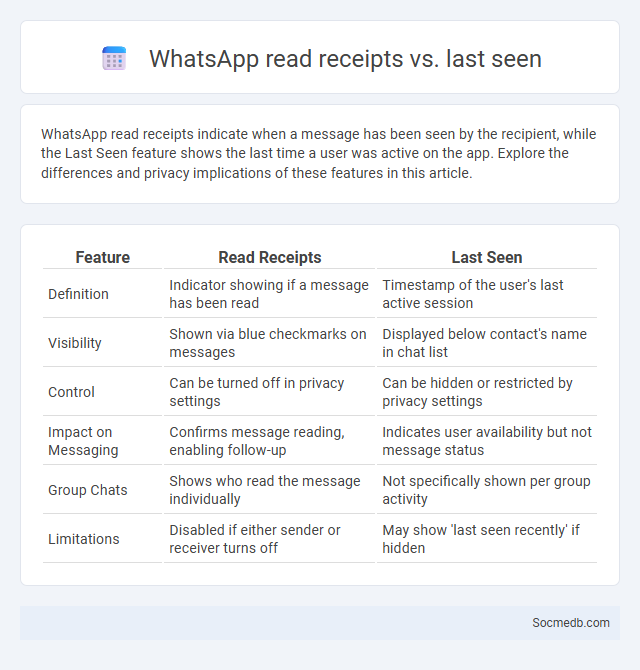
Photo illustration: WhatsApp read receipts vs last seen
WhatsApp read receipts indicate when a message has been seen by the recipient, while the Last Seen feature shows the last time a user was active on the app. Explore the differences and privacy implications of these features in this article.
Table of Comparison
| Feature | Read Receipts | Last Seen |
|---|---|---|
| Definition | Indicator showing if a message has been read | Timestamp of the user's last active session |
| Visibility | Shown via blue checkmarks on messages | Displayed below contact's name in chat list |
| Control | Can be turned off in privacy settings | Can be hidden or restricted by privacy settings |
| Impact on Messaging | Confirms message reading, enabling follow-up | Indicates user availability but not message status |
| Group Chats | Shows who read the message individually | Not specifically shown per group activity |
| Limitations | Disabled if either sender or receiver turns off | May show 'last seen recently' if hidden |
Understanding WhatsApp Read Receipts
WhatsApp read receipts indicate when your message has been seen by the recipient, confirmed by the double blue check marks. You can manage your privacy settings to control whether others see your read receipts, balancing transparency and confidentiality. Understanding these features enhances your communication by setting clear expectations about message visibility on the platform.
What Does “Last Seen” on WhatsApp Mean?
"Last Seen" on WhatsApp indicates the last time your contact used the app, providing a timestamp of their recent activity. This feature helps you understand when someone was last online without sending a message. Your privacy settings control who can view your own "Last Seen" status, allowing you to manage your visibility on social media effectively.
Key Differences: Read Receipts vs Last Seen
Read receipts show when a message has been opened by the recipient, providing direct confirmation of engagement within platforms like WhatsApp and Instagram. Last seen indicates the most recent time a user was active on the platform, offering a general status update instead of message-specific information. Understanding these distinctions helps users manage privacy preferences and communication expectations across social media apps.
How to Enable or Disable Read Receipts
To enable or disable read receipts on social media platforms like WhatsApp, Instagram, or Facebook Messenger, navigate to the privacy or message settings within the app. You can toggle the read receipts option to control whether others see if you've read their messages or not. Your choice affects both your privacy and the interaction transparency with friends or followers.
Managing Your “Last Seen” Privacy
Managing your "Last Seen" privacy on social media platforms allows you to control who can view the timestamp of your last activity, enhancing your online privacy and reducing unwanted attention. Adjusting these settings helps protect your personal schedule and prevents others from tracking your online presence in real-time. You can customize visibility options to specific friends, contacts, or completely hide it for maximum privacy.
Privacy Implications of Read Receipts and Last Seen
Read receipts and last seen features on social media platforms can expose your online activity patterns, potentially compromising your privacy by revealing when you are active and who you communicate with most frequently. Controlling these settings helps limit unnecessary exposure of personal information to contacts and strangers alike, reducing the risk of unwanted surveillance or profiling. You should regularly review and adjust privacy options to maintain control over your digital footprint and protect sensitive interactions from being monitored.
Read Receipts in Individual vs Group Chats
Read receipts in individual chats provide precise confirmation when a specific recipient has viewed a message, enhancing personal communication clarity and responsiveness. In group chats, read receipts aggregate multiple participants' statuses, offering insights into who has seen the message but often without timestamp granularity per individual. This difference impacts user experience by balancing privacy concerns and informational transparency, with some platforms allowing customization of read receipt visibility for different chat types.
Common Misconceptions About WhatsApp Privacy
WhatsApp privacy is often misunderstood, with many users believing end-to-end encryption means complete anonymity, which is not the case since metadata like who you contact and when is still accessible. Your messages and calls are encrypted, ensuring only you and the recipient can read them, but WhatsApp does collect data such as phone numbers, device information, and usage patterns for operational purposes. Understanding these distinctions helps you manage privacy settings effectively and avoid common pitfalls regarding what data is truly private on the platform.
Tips to Control Your WhatsApp Online Status
To control your WhatsApp online status, adjust your privacy settings by navigating to Settings > Privacy > Last Seen & Online, where you can select who sees your activity: Everyone, My Contacts, My Contacts Except, or Nobody. You can also disable the "Last Seen" feature to prevent others from knowing when you were last active and turn off your online status to appear offline while using the app. These adjustments help you maintain your privacy and manage your social media presence effectively.
Choosing the Best Settings for Your Privacy Needs
Adjusting social media privacy settings allows users to control who can view their posts, profile information, and personal data, minimizing exposure to unwanted audiences. Enabling features like two-factor authentication and limiting third-party app access strengthens account security. Regularly reviewing privacy options ensures alignment with evolving personal preferences and platform updates, safeguarding digital identity effectively.
 socmedb.com
socmedb.com